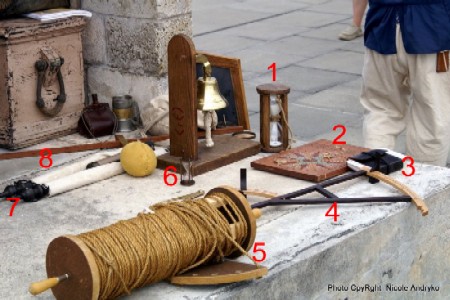
Pirates in Paradise 2008 - Key West, Fl
Extra Page: Dutch Explains 18th Century Navigation
(Photo: Nicole Andreyko, Callahan Digital Art)
"Dutch" has a storehouse of knowledge about
navigation and he enjoys giving informative presentations to help the
public understand this art. Before he was even sure he could go to PiP
this year, he was busily encouraging me to set up a Living History
display at the event with my surgical equipment as one of the stations.
So it came as no surprise that he gave several presentations on the
topic.
Dutch has read a great deal about this topic and has acquired the tools necessary to give an excellent presentation. Navigation was very much an art during the golden age of pyracy and the tools were rather primitive in comparison to what we have today. There were no compasses, nor even clocks reliable enough to give sailors an accurate longitude reading. So Dutch had his work cut out for him.
|
|
|
Above left: Dutch explains the lead line, used for taking depth measurements at sea. At right: Dutch uses the Davis Backstaff to take a latitude reading.
|
|
|
Above left: Dutch showing the chip log. The pie-shaped board is called the chip or fish. It is cast over the back of the moving ship and allowed to pay out. Knots every 47 feet 3 inches passed through a sailor's fingers, while another sailor used a small sandglass to time the operation. (Thanks to MadL for this explanation.) Above right: Dutch shows the traverse board. It is a sort of memory aid used to record how far and in what direction the ship had traveled during a four-hour watch. Below right you see the bulk of Dutch's collection of navigational equipment, with helpful explanatory numbers.

(Photo: Nicole Andreyko, Callahan Digital Art)
- One Hour Sand Glass - used to keep the ship's watch times.
- Traverse Board - see above description.
- Navigator's Log Book - where observations about wind, speed, direction, latitude and so forth were recorded.
- Davis Back Staff - see above.
- Chip Log Board - see above.
- 28 Second Sand Glass - used to calculate the ship's speed.
- Ship's Lines (a drawing of the Luna.)
- Cross Staff - predecessor of the Back Staff, used to measure longitude.
Not numbered are the ship's bell, the yellow model of the earth, and Dutch's mug.
